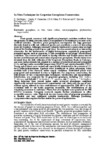Use este identificador para citar ou linkar para este item:
http://www.alice.cnptia.embrapa.br/alice/handle/doc/1032995Registro completo de metadados
| Campo DC | Valor | Idioma |
|---|---|---|
| dc.contributor.author | BOSCO, D. D. | pt_BR |
| dc.contributor.author | SINSKI, I. | pt_BR |
| dc.contributor.author | COMACHIO, V. | pt_BR |
| dc.contributor.author | MAIA, J. D. G. | pt_BR |
| dc.contributor.author | RITSCHEL, P. S. | pt_BR |
| dc.contributor.author | QUECINI, V. | pt_BR |
| dc.date.accessioned | 2016-01-05T11:11:11Z | pt_BR |
| dc.date.available | 2016-01-05T11:11:11Z | pt_BR |
| dc.date.created | 2016-01-05 | pt_BR |
| dc.date.issued | 2015 | pt_BR |
| dc.identifier.citation | Acta Horticultura, n. 1082, Apr. 2015. p. 201-206. | pt_BR |
| dc.identifier.uri | http://www.alice.cnptia.embrapa.br/alice/handle/doc/1032995 | pt_BR |
| dc.description | Abstract Plant genetic resources hold significant phenotypic variation resultant from the presence of allelic diversity, which is maintained by evolutionary processes or by artificial selection. Therefore, plant germplasm encompasses the huge genotypic diversity found in wild and cultivated species and constitutes a source of interesting traits for breeders. Although extremely valuable, biodiversity conservation has high demand for funding, physical space and labor. In vitro conservation is an interesting alternative for the maintenance of highly-heterozygous, vegetatively propagated, perennial species, such as grapevine. It also contributes to the plants? phytosanitary conditions. The current work aimed to develop effective and feasible means toward in vitro establishment and conservation of grapevine germplasm. Woody stakes were obtained from the field collection of the Grapevine Germplasm Bank, at Embrapa, and were surface disinfected, planted in a mixture of autoclaved soil and vermiculite (1:1), and kept under controlled temperature (23±5°C) and relative humidity (70%). Young apical shoots were excised and superficially disinfected in the presence of 1% (w/v) polyvinylpirrolidone. Explants were transferred to tubes containing Galzy medium with active charcoal, under aseptic conditions. Established plants were propagated and maintained in vitro as duplicates. For long-term conservation, the effectiveness of two cryopreservation techniques; vitrification and encapsulationdehydration, was compared for 11 grapevine genotypes, including Vitis vinifera, V. labrusca and hybrids V. berlandieri × V. rupestris, and V. riparia × V. berlandieri. Shoot induction from treated stakes under protected greenhouse conditions significantly reduced environmental contamination and, along with the use of antioxidant agents, allowed in vitro establishment of approximately 1200 (85% of the accessions held by the bank) grapevine accessions. The establishment of the remaining accessions is underway. Plants free of ectophytes were produced for 900 (64.3%) accessions. Cryogenic protocols require further adjustments to allow acceptable recovery rates. High-scale in vitro conservation of grapevine germplasm is feasible and may safeguard valuable biodiversity. Although promising, cryopreservation requires further studies for protocol optimization. | pt_BR |
| dc.language.iso | por | pt_BR |
| dc.rights | openAccess | pt_BR |
| dc.subject | Phytosanitary improvement | pt_BR |
| dc.subject | In vitro | pt_BR |
| dc.title | In Vitro techniques for grapevine germplasm conservation. | pt_BR |
| dc.type | Artigo de periódico | pt_BR |
| dc.date.updated | 2016-03-17T11:11:11Z | pt_BR |
| dc.subject.nalthesaurus | Germplasm | pt_BR |
| dc.subject.nalthesaurus | Tissue culture | pt_BR |
| dc.subject.nalthesaurus | Micropropagation | pt_BR |
| riaa.ainfo.id | 1032995 | pt_BR |
| riaa.ainfo.lastupdate | 2016-03-17 | pt_BR |
| dc.contributor.institution | DANIELA DAL BOSCO, CNPUV; IRACI SINSKI, CNPUV; VALTAIR COMACHIO, CNPUV; JOAO DIMAS GARCIA MAIA, CNPUV; PATRICIA SILVA RITSCHEL, CNPUV; VERA MARIA QUECINI, CNPUV. | pt_BR |
| Aparece nas coleções: | Artigo em periódico indexado (CNPUV)  | |
Arquivos associados a este item:
| Arquivo | Descrição | Tamanho | Formato | |
|---|---|---|---|---|
| RitschelActahortn1082Apr2015.pdf | 481,5 kB | Adobe PDF |  Visualizar/Abrir |









